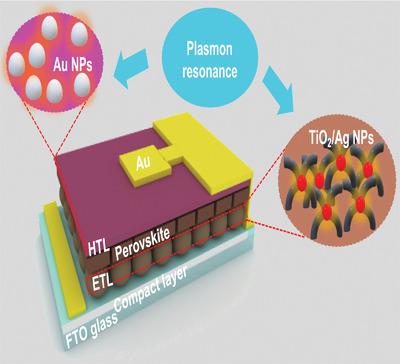Our official English website, www.x-mol.net, welcomes your feedback! (Note: you will need to create a separate account there.)
Recent Advances in Plasmonic Perovskite Solar Cells.
Advanced Science ( IF 15.1 ) Pub Date : 2020-05-04 , DOI: 10.1002/advs.201902448 Roozbeh Siavash Moakhar 1 , Somayeh Gholipour 2 , Saeid Masudy-Panah 3, 4 , Ashkan Seza 1 , Ali Mehdikhani 1 , Nastaran Riahi-Noori 1 , Saeede Tafazoli 1 , Nazanin Timasi 1 , Yee-Fun Lim 5 , Michael Saliba 6, 7, 8
Advanced Science ( IF 15.1 ) Pub Date : 2020-05-04 , DOI: 10.1002/advs.201902448 Roozbeh Siavash Moakhar 1 , Somayeh Gholipour 2 , Saeid Masudy-Panah 3, 4 , Ashkan Seza 1 , Ali Mehdikhani 1 , Nastaran Riahi-Noori 1 , Saeede Tafazoli 1 , Nazanin Timasi 1 , Yee-Fun Lim 5 , Michael Saliba 6, 7, 8
Affiliation

|
Perovskite solar cells (PSCs) have emerged recently as promising candidates for next generation photovoltaics and have reached power conversion efficiencies of 25.2%. Among the various methods to advance solar cell technologies, the implementation of nanoparticles with plasmonic effects is an alternative way for photon and charge carrier management. Surface plasmons at the interfaces or surfaces of sophisticated metal nanostructures are able to interact with electromagnetic radiation. The properties of surface plasmons can be tuned specifically by controlling the shape, size, and dielectric environment of the metal nanostructures. Thus, incorporating metallic nanostructures in solar cells is reported as a possible strategy to explore the enhancement of energy conversion efficiency mainly in semi‐transparent solar cells. One particularly interesting option is PSCs with plasmonic structures enable thinner photovoltaic absorber layers without compromising their thickness while maintaining a high light harvest. In this Review, the effects of plasmonic nanostructures in electron transport material, perovskite absorbers, the hole transport material, as well as enhancement of effective refractive index of the medium and the resulting solar cell performance are presented. Aside from providing general considerations and a review of plasmonic nanostructures, the current efforts to introduce these plasmonic structures into semi‐transparent solar cells are outlined.
中文翻译:

等离激元钙钛矿太阳能电池的最新进展。
钙钛矿太阳能电池 (PSC) 最近已成为下一代光伏发电的有希望的候选者,其电力转换效率已达到 25.2%。在推进太阳能电池技术的各种方法中,具有等离子体效应的纳米粒子的实现是光子和电荷载流子管理的另一种方法。复杂金属纳米结构界面或表面的表面等离子体能够与电磁辐射相互作用。表面等离子体激元的特性可以通过控制金属纳米结构的形状、尺寸和介电环境来具体调节。因此,据报道,在太阳能电池中加入金属纳米结构是探索提高半透明太阳能电池能量转换效率的一种可能策略。一种特别有趣的选择是具有等离子体结构的 PSC 可以在不影响其厚度的情况下实现更薄的光伏吸收层,同时保持高光收获。在这篇综述中,介绍了等离子体纳米结构在电子传输材料、钙钛矿吸收剂、空穴传输材料中的作用,以及介质有效折射率的增强和由此产生的太阳能电池性能。除了提供一般考虑因素和对等离子体纳米结构的回顾之外,还概述了当前将这些等离子体结构引入半透明太阳能电池的努力。
更新日期:2020-07-08
中文翻译:

等离激元钙钛矿太阳能电池的最新进展。
钙钛矿太阳能电池 (PSC) 最近已成为下一代光伏发电的有希望的候选者,其电力转换效率已达到 25.2%。在推进太阳能电池技术的各种方法中,具有等离子体效应的纳米粒子的实现是光子和电荷载流子管理的另一种方法。复杂金属纳米结构界面或表面的表面等离子体能够与电磁辐射相互作用。表面等离子体激元的特性可以通过控制金属纳米结构的形状、尺寸和介电环境来具体调节。因此,据报道,在太阳能电池中加入金属纳米结构是探索提高半透明太阳能电池能量转换效率的一种可能策略。一种特别有趣的选择是具有等离子体结构的 PSC 可以在不影响其厚度的情况下实现更薄的光伏吸收层,同时保持高光收获。在这篇综述中,介绍了等离子体纳米结构在电子传输材料、钙钛矿吸收剂、空穴传输材料中的作用,以及介质有效折射率的增强和由此产生的太阳能电池性能。除了提供一般考虑因素和对等离子体纳米结构的回顾之外,还概述了当前将这些等离子体结构引入半透明太阳能电池的努力。


























 京公网安备 11010802027423号
京公网安备 11010802027423号